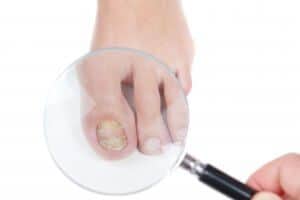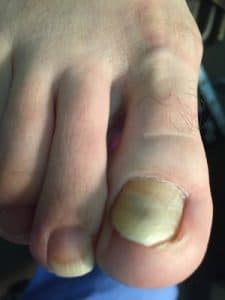Toenail Fungus

Best Treatments For Toenail Fungus
In mild toenail fungus cases many patients choose not to seek treatment. Aside from increasing the risk of bacterial infection onychomycosis poses no real danger. In mild cases it’s common for patients not to seek treatment. In more advanced cases many patients find the condition (very) unsightly and opt for treatment. Ultimately it’s up to the patient whether or not he or she is bothered enough to take action.
- Topical Antifungals
- Periodic Debridement by a Podiatrist
- Oral Medications
- Laser Treatment
Causes of toenail fungus (onychomycosis)
 All such infections are caused by fungal organisms that thrives in the moist environment the feet offer. The most common is called dermatophyte fungus. Other common offenders are common yeast and even mold.
All such infections are caused by fungal organisms that thrives in the moist environment the feet offer. The most common is called dermatophyte fungus. Other common offenders are common yeast and even mold.
This can happen to patients at any age, but as with many other foot problems it’s most common in older adults. Nails become brittle with age, resulting in the formation of tiny cracks, which give fungus a way in. If a person is diabetic or has a weakened immune system due to some medications, then the chances of infection go up.
As noted, the same fungus which causes athlete’s foot also causes nail fungus. It’s entirely possible to have one progress to the other, as well as the infection spreading from nail to nail. Person to person transmission is much rarer.
Risk factors for toenail fungus
The following is a list of the most commonly seen risk factors:
Older age often leads to both reduced blood flow to the nail bed, and more years of exposure to the fungus.
Heavy sweating, as seen in athletes, leads to a more moist environment.
A history of tinea pedis (athlete’s foot).
In moist, public areas such as locker rooms, showers, and swimming pools, a history of walking barefoot.
Having pre-existing injuries of the nail or surrounding skin. This can allow the fungus access to the tissue beneath the nail.
A history of other skin conditions of the foot, such as psoriasis.
Being a diabetic patient, which can mean decreased circulation in the feet.
Having a compromised immune system, as seen with certain medications and other infections such as HIV.
Possible complications
 If a case of onychomycosis is severe enough, it can be quite painful, as the skin beneath the nails is very sensitive. The nail can become ingrown. Permanent damage is also possible in severe cases. Another obvious complication is the infection spreading to other nails (or even the other foot).
If a case of onychomycosis is severe enough, it can be quite painful, as the skin beneath the nails is very sensitive. The nail can become ingrown. Permanent damage is also possible in severe cases. Another obvious complication is the infection spreading to other nails (or even the other foot).
With diabetes often comes a decreased nerve supply leading to reduced sensation. Poor circulation is also common. This means that diabetic feet are more prone to any type of infection, including fungal. The lack of sensation also means that people often damage their foot without them feeling it, such as repetitive trauma from tight shoes. As with any other type of trauma, this can allow fungus a way in. It bears repeating: it’s essential for diabetics to be under a podiatrist’s care.
Preventing toenail fungus
Good hygiene and foot care practices are the best way to prevent any type of infection, especially the fungal infections which cause onychomycosis.
Wash feet regularly and thoroughly with every bath or shower. Wash your hands after handling an infected nail.
When trimming nails, cut them straight across, smooth the edges with a file, and gently file down any thickened areas. Clean clippers with alcohol or other disinfectant after use.
Change socks as often as feasible. Cotton socks are best.
Choose breathable shoes, such as running shoes.
Don’t keep shoes beyond the point of their useful life. Older shoes contain more fungal spores. Conversely, treat all shoes, especially old ones, with antifungal powder.
In moist environments such as locker rooms, wear sandals at all times.
Make sure nail salons you frequent are hygienic in appearance. A new set of sterilized instruments must be used for each client.
Don’t wear nail polish or artificial nails. Both prevent the nail from breathing and make fungal infections worse.
Diagnosing nail fungus
This is done by physical examination. If there’s any doubt, clippings and debris scrapings can be sent in for identification. This will identify specifically which organism is causing the infection.
Some conditions, namely psoriasis, often look like onychomycosis. Once the true cause is known, the most appropriate treatment can be started.
Toenail fungus (onychomycosis)
While often referred to as “toenail fungus” or simply “nail fungus” the medical term for this type of fungal infection is onychomycosis. It’s extremely common, especially in wetter regions, and it’s also very difficult to get rid of. Only recently have truly effective treatments become available to podiatrists which can clear an infection completely and permanently.
Onychomycosis typically starts as whitish or yellowish spots beneath the nail at the tip of the nail bed. As the infection progresses the fungus can colonize large portions of the nail bed as well as the nail itself. Advanced cases can cause discomfort due to inflammation (and occasionally secondary infection) but the condition’s hallmark symptoms are cosmetic. These include further discoloration, thickening, and an uneven, often wavy texture. The nails tend to become brittle and crumble at the tip, and flaky debris can be found beneath the nail. Severe cases of onychomycosis are often accompanied by an unpleasant yeasty odor. This condition can affect one or several toes but is most often found beneath the toenail of the big (first) toe.
Can nail polish or acrylic nails contribute to toenail fungus?
Yes, the use of nail polish or acrylic nails can potentially contribute to toenail fungus. These cosmetic treatments create a sealed environment around the nail, providing a dark and moist space where fungi thrive. Prolonged use of nail polish or acrylic nails may trap moisture and lead to the development or worsening of toenail fungus. It’s essential to allow nails to breathe and maintain good nail hygiene to reduce the risk of fungal infections.
Can toenail fungus be a sign of an underlying health issue?
Yes, toenail fungus can serve as a potential indicator of underlying health issues due to several reasons and associated conditions.
1. Immune System Compromise: Conditions that weaken the immune system, such as HIV/AIDS or autoimmune disorders, increase susceptibility to fungal infections.
2. Diabetes: Elevated blood sugar levels create an environment conducive to fungal growth, making individuals with diabetes more prone to toenail fungus.
3. Circulatory Disorders: Poor circulation, often linked to cardiovascular problems, reduces the body’s ability to effectively combat and prevent toenail fungus.
4. Peripheral Vascular Disease: Reduced blood flow to extremities can contribute to fungal infections in the toenails.
5. Psoriasis or Eczema: These skin conditions can affect the nails, making them more susceptible to fungal infections.
Is it possible to have toenail fungus without visible symptoms?
Yes, it is possible to have toenail fungus without visible symptoms, especially in the early stages of infection. In some cases, toenail fungus may develop beneath the nail surface before causing noticeable changes to the nail’s appearance. As the infection progresses, common symptoms may include discoloration, thickening, brittleness, or a distorted shape of the nail.
Individuals with a weakened immune system or certain health conditions may be more prone to asymptomatic toenail fungus. Additionally, some people may carry the fungus without showing visible signs but can still spread it to others.
